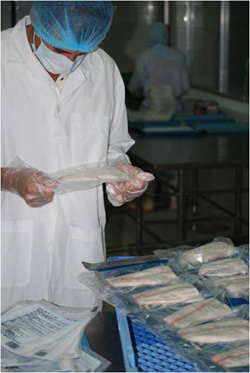When It Comes To Fish, Flash Frozen Is Almost Always ‘Fresher Than Fresh’When It Comes To Fish, Flash Frozen Is Almost Always ‘Fresher Than Fresh’ “Fresh” is a powerful adjective and most chefs and consumers pay a premium for fresh fish. But is fresh fish really superior to frozen? “Fresh” is a powerful adjective and most chefs and consumers pay a premium for fresh fish. But is fresh fish really superior to frozen?Consider These FactsThe quality of fish begins to deteriorate immediately after harvest. Most fresh fish spends one to two weeks in the cold chain before it reaches your plate. Wild caught seafood can easily be 7-10 days old by the time it reaches the harbor; 2-6 days traveling to and from the fishing grounds, 3-5 days fishing, plus another 2-4 days to be processed and distributed. If the demand is lethargic or the price isn't right, the seafood waits. At the store, it may be several more days before it is purchased. Hopefully, your refrigerator isn’t adding to the problem, but in many busy homes, it may well be. In contrast, modern freezing methods retain quality, nutritional benefits and seals in the fresh flavor until you’re ready to cook.Popular fish like Tuna and Salmon are frozen at sea on the ships. Although we like to think it’s to preserve the integrity and nutrition of the catch it’s really good old fashioned capitalism at work. The retention of quality and nutrition is just a bonus. Once the technology was developed back in the 70’s it became apparent to the industry boats could stay out longer, fish over wider areas (helping with sustainability) and reduce waste through spoilage to almost nothing! The clear benefits arrive on our dinner tables every day with high-quality seafood in any season at incredibly reasonable prices. It also makes for cleaner seafood as there are no preservatives, color enhancers etc. necessary. Blind Taste TestsTaste tests have shown that if fish is frozen immediately after harvest using modern techniques trained panelists generally prefer it to fresh fish which is 3 or more days old. For most of us, it's impossible to tell frozen fish apart from fresh fish that was caught only hours before. In fact, Eat-Well guarantees our fish to be amazing or we will replace your unused portions with any menu item of equal value. Another interesting thing our clients shared with us is that when cooking our fish the house doesn't stink of fish for 2 days and there is zero mess in the kitchen. Plus no waste gets thrown in the garbage so the raccoons and cats keep out of the trash. One fish bone can be smelled from miles around.What Exactly is Flash Frozen? Most portion controlled seafood is flash frozen within 4 hours of harvest and frozen using state-of-the-art Japanese belt freezing systems that take less than 10 minutes to chill the portions to 30°F below zero. The filets are then dipped in water to provide additional protection against dehydration and individually vacuum packed. Some fish has an icy glaze and this is normal so don’t worry, it’s just water. Flash Frozen Fish is Green“Go local. Eat Organic. Buy Fresh." Those food mantras continue to make wave among environmentally conscious consumers. But – as is often the case in these climate-conscious times – if the motivation is to truly make our diets more earth-friendly, then perhaps we need a new mantra: Buy frozen. |


